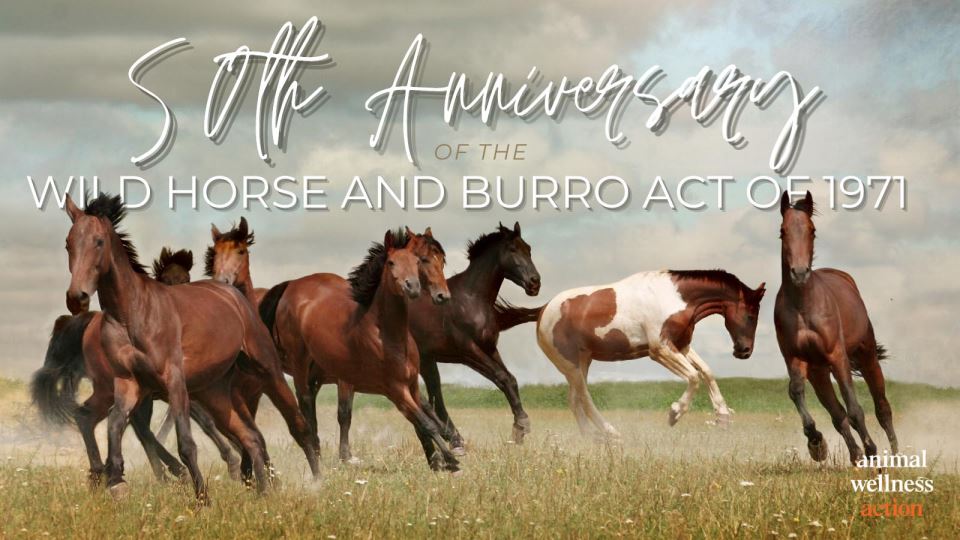On December 15th, 1971, the Wild and Free-Roaming Horses and Burros Act was signed into law by President Nixon. But instead of commemorating the half-century mark of the Act with responsible and humane stewardship of our wild herds, the Bureau of Land Management is in the midst of the largest mass helicopter roundup in its history, targeting over 3,500 beautiful Wyoming mustangs with persecution, incarceration, and, for some, inevitably, death in a foreign slaughter plant.
The Wyoming operation follows the agency’s roundup of hundreds of horses from Colorado’s beloved Sand Wash Basin herd, a horrific spectacle that sparked widespread outrage among Coloradoans, including the state’s governor, who appealed to the Bureau to find a different approach. As is the Bureau’s modus operandi, it disregarded the public’s wishes and gave its helicopter contractors the green light. Now, just weeks later, thousands of sheep are grazing in the area that the agency claimed had too little forage to support a few hundred horses.
The Bureau enjoys political cover for its cruelty and mismanagement from a nefarious plan called the “Path Forward,” a handshake deal hatched by the livestock industry in collaboration with Humane Society of the United States and the ASPCA, who inexplicably betrayed the very animals they feature in their fundraising campaigns.
Benefiting commercial livestock grazing above all other uses on designated wild horse and burro habitat, the Path Forward calls for reducing wild herds to 1971 levels, and relies almost exclusively on helicopter roundups to manage populations. Under the Path Forward, the Bureau is engaging in the same cruel practices that led the American people to demand federal protections in the first place.
In April of 2021, some 70 conservation and wild horse groups petitioned Secretary of the Interior Deb Haaland to stop prioritizing overgrazing by livestock on lands designated for the wild equines. The petition was prompted by the government’s policy of allowing commercial livestock to remove most of the annual grass production in wild horse Herd Management Areas, leaving wild horses to split the leftovers with other wild herbivores, rabbits, rodents, and insects. Yet Secretary Haaland failed to even acknowledge the petition, instead silently standing by while the Bureau repeats the ”wild horse overpopulation” lie that omits mention of the impacts of millions of commercial livestock on our public lands.
One of the first major roundups of 2021 was at the Onaqui Mountain Herd Management Area west of Salt Lake City, Utah, one of the nation’s most heavily-visited wild horse viewing destinations. The BLM declared that an “emergency gather” was needed because poor range conditions (caused by the agency’s own authorization of excessive livestock) put the Onaqui horses in danger of starvation.
When an animal welfare group sued to stop the roundup, a Bureau official testified under oath that the wild horses were in poor body condition, thereby justifying the emergency gather. But once a majority of the Onaqui horses were in captivity, the Bureau changed its story and conceded that the animals were actually in good condition and nowhere near starvation. The agency’s fraud and gaslighting were a success and the ranchers were happy. Meanwhile, hundreds of beloved Onaqui horses now stand, defeated and depressed, in barren BLM corrals.
Animal Wellness Action and the Center for a Humane Economy have taken a leadership role in driving the national conversation about a new approach to protecting our nation’s wild horse and burro herds. We understand that in the final analysis, federal agencies are commemorating the Wild and Free-Roaming Horses and Burros Act by repeatedly violating its mandates. That’s why we believe the only logical avenue for reform lies in groundbreaking legislation that forces the Bureau to adopt a new approach that is humane, sustainable, and that restores the rightful place of our beloved wild mustangs and burros to live wild and free on our public lands, as President Nixon, Congress, and the American people envisioned on this day 50 years ago.
